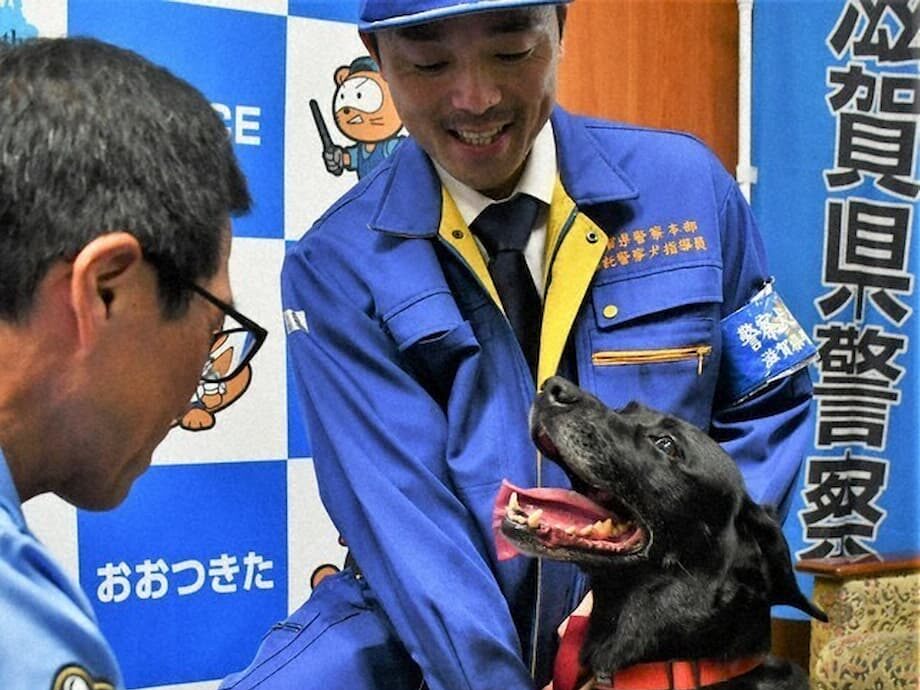Inside the nighttime search in Otsu
A Labrador retriever named Heart led police to a missing elderly woman after midnight in Otsu, Shiga Prefecture. The Otsu Kita Police Station said a resident reported the woman missing around 8 p.m. on July 28. Heart, an 8 year old female with a calm demeanor and a tireless nose, began work around 11 p.m. after sniffing the woman’s pillow cover to take in her scent. By 12:45 a.m., a police officer following Heart found the woman on a city road. She was located safely and returned to her family.
Police recognized the team soon after. Letters of gratitude went to Heart of Eurostars JP-go, to her owner Tomoko Tobita, and to her trainer Tessei Sugimoto. Police station chief Keisuke Yasuda said the late hour and difficult conditions made the quick find a major help to the search. During the small ceremony, Yasuda also offered Heart a snack shaped like a bone. Witnesses described the dog wagging her tail before flopping on the floor with a content look.
According to the station, the dog used the pillow cover as a scent source, then sampled the air to identify where the odor seemed strongest. That allowed the team to narrow the search area. An officer shadowed the handler at a safe distance while watching the dog’s body language. When Heart indicated a route change, the officer checked nearby streets and soon spotted the missing woman on foot.
The outcome adds to a growing list of rescues in the area that involve canine help in partnership with first responders. In a separate case in 2022, a local dog named Fukusuke guided rescuers to a missing hiker in the Hira Mountains, a rescue later commended by both the Otsu Fire Department and the Otsu Kita Police Station. Details of that case were reported by The Asahi Shimbun’s English edition and can be read here.
What happened on July 28
At about 8 p.m., a resident told police that an elderly woman they lived with had not returned and could not be found. Officers canvassed the area and coordinated a search. The call for a trained dog went out after initial checks did not locate the woman. Around 11 p.m., Heart arrived with her handler and took in the scent from the woman’s pillow cover to ensure the dog would search for the right person.
Handlers often start in places where a missing person was last seen, then let the dog work into the wind or along likely walking routes. In this case, Heart followed faint odor cues that drifted through the neighborhood. The dog’s harness was on, a signal that it was time to work. When the animal showed a decisive pull down one stretch and then another, the team adjusted direction. A police officer trailing the search team then found the woman at 12:45 a.m. on a road in the city.
The woman had been missing for several hours, and nighttime searches bring extra risks. Street lighting can be uneven, traffic moves with less visibility, and fatigue can set in for both searchers and the person being sought. A dog can shorten the time needed to reach a likely area, which can be critical for an older adult who may be disoriented or at risk of falling.
Who is Heart and her team
Heart of Eurostars JP-go is an 8 year old female Labrador retriever. She is privately owned by Tomoko Tobita and trained by Tessei Sugimoto. Police thanked all three, the dog, the owner, and the trainer, with formal letters of appreciation.
According to Sugimoto, Heart is relaxed during downtime. The tone changes as soon as her harness is attached. The dog becomes focused and holds attention for long periods, which matters during hours long searches. That ability to switch from calm to alert and back again helps working dogs stay effective without burning out.
Labrador retrievers are among the breeds most often seen in detection and search roles. The combination of a powerful nose, stamina, and a friendly temperament makes them suitable for work in public spaces. Many individuals also have a high desire to work with a human partner, which helps on complex searches through streets, parks, or wooded edges.
In Japan, many search dogs operate with civilian handlers who train through local clubs or nonprofit groups. Police and fire departments sometimes call these teams when there is a need to expand a search quickly. Handlers rotate dogs, manage rest, and keep detailed notes on wind and terrain so that the next pass through an area picks up where the last one left off.
How scent tracking works
Every person leaves a unique scent trail that includes skin cells and other tiny particles. Dogs can detect very faint traces that people cannot perceive. When a handler gives a dog a sample such as a pillow cover or a shirt, the dog learns the target scent and ignores other odors. This is called scent discrimination.
Search dogs work in different ways. A trailing dog might stay close to the path taken by a person. An air scent dog lifts its nose high and tries to catch a cone of odor that the wind pushes downrange. Each method has strengths. Trailing can be useful in tight city blocks. Air scent work can quickly scan larger spaces such as parks or riverbanks.
Conditions shape how a search unfolds. Warm air can lift scent above the ground, while cool air can pool scent in low spots. Wind can bend and break a scent cone, which creates false turns or confusing gaps. Urban hard surfaces hold less scent than grass or leaf litter. Handlers read a dog’s shifts in speed and head position to decide when to circle, when to cast wider, and when to push forward.
That may explain why a start time of 11 p.m. still produced results. After sunset, traffic tends to drop in residential areas, wind often settles, and cooler air can hold scent closer to the ground. With fewer competing odors, a trained dog can lock onto a target scent and follow it to a workable area for police to search more closely.
Missing seniors and why speed matters
Japan has one of the oldest populations in the world. Police nationwide field many missing person reports every year, and a significant share involve older adults living with dementia. Many individuals are located within hours, often by family, neighbors, or patrol officers. When searches run into the night or cover a wide area, a dog team can add speed.
People with cognitive decline can wander from familiar places, forget where they are going, or keep walking after dark. The risks increase near busy roads, waterways, steep slopes, or winter conditions. Rapid searches can prevent injury from falls, traffic encounters, or exposure.
Shiga Prefecture includes Lake Biwa, wooded hills, and suburban neighborhoods. These mixed settings suit dog work because scent can drift from sidewalks into hedges or across open fields. A dog can check these spaces faster than a line of people on foot.
Community rescues in Otsu
Local history supports the value of these partnerships. In late December 2021, a man went missing in the Hira mountain range. A resident named Tetsuro Ueda joined the search with his dog Fukusuke and heard a distant whistle. Ueda had left his phone at home. Searchers later encountered Fukusuke, who led them to the hiker and checked back to keep the humans on the right path. The Otsu Fire Department and the Otsu Kita Police Station later presented commendations for the rescue, which was reported by The Asahi Shimbun’s English site.
That case featured an everyday dog and a neighbor with local knowledge who supported official crews. In the present case, a trained Labrador and handler helped police cover ground quickly in the late evening hours. Both cases point to the same theme, that many eyes and noses make for faster finds when minutes count.
Formal thanks from police carry weight in a community where residents and authorities often work side by side. Recognition helps keep volunteers engaged and ready to respond the next time someone goes missing.
What families can do if someone goes missing
Quick action improves the odds of a safe return. If a family member or neighbor disappears and you cannot contact them, call 110 in Japan to report a missing person. Provide the time last seen, clothing, medical needs, and places the person enjoys. Tell police if there is an item with the person’s scent that can be used by a dog, such as a pillowcase or a shirt from a dirty laundry basket.
The steps below reflect common guidance from search teams and community safety programs.
- Preserve a scent item in a clean paper bag or pillowcase, and avoid plastic if possible to reduce moisture that can mix odors.
- Retrace safe and predictable routes, and check benches, bus stops, convenience stores, and familiar parks.
- Alert neighbors and building managers, and ask about any camera footage that might show a direction of travel.
- Keep phones available and ensure someone stays at home in case the person returns.
- Bring a recent photo and note any unique traits such as a distinctive walk or a favorite hat.
- Turn on exterior lights and check sheds, stairwells, and quiet corners around the property.
- Provide a list of medications and health needs to police and note any risk factors such as a history of falls.
- If a dog team is coming, avoid handling the preserved scent article, keep pets away from it, and close windows in the room where the item was taken.
These actions help both patrol officers and dog teams focus quickly on the right places and the right scent. They also give police a clearer picture of nearby risks, such as water features or busy intersections.
Recognition and community readiness
The small touches of the Otsu ceremony mattered. Chief Keisuke Yasuda publicly thanked the team and handed Heart a snack shaped like a bone. The dog wagged her tail and sprawled on the floor with a relaxed expression. Moments like this humanize police work and remind residents that many rescues depend on patience, training, and simple rewards for good behavior.
Heart’s case shows how official responders, civilian handlers, and everyday neighbors can share the load. Police run incident command and keep searches safe. Dog teams bring a special sense for odor that can cut hours off a search. Residents offer local knowledge of shortcuts, riverbanks, and stairways that do not show up on a map.
That mix can be the difference on a rainy night or a winter evening when temperatures drop fast. The more people who know what to do, the smoother the next search will unfold.
Key Points
- Labrador retriever Heart helped Otsu police locate a missing elderly woman after midnight.
- The woman was reported missing around 8 p.m. on July 28, and was found at 12:45 a.m. on a city road.
- Heart started work around 11 p.m. after sniffing the woman’s pillow cover to learn the target scent.
- Otsu Kita Police Station issued letters of gratitude to the dog, her owner Tomoko Tobita, and her trainer Tessei Sugimoto.
- Police chief Keisuke Yasuda praised the quick find and rewarded Heart with a snack shaped like a bone.
- The case highlights how trained dogs can speed up searches for missing seniors at night.
- Otsu authorities have previously recognized canine help, including a 2022 mountain rescue led by a dog named Fukusuke.
- Families can support searches by calling 110 quickly, preserving a scent item, and sharing accurate details with police.




